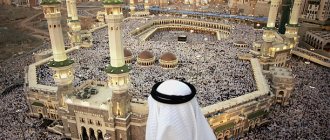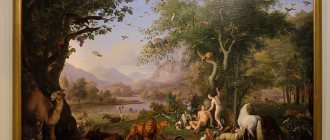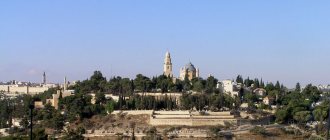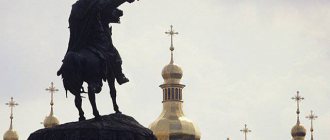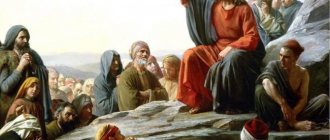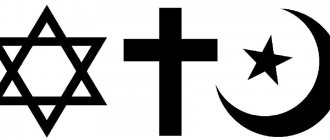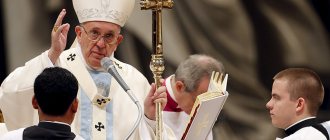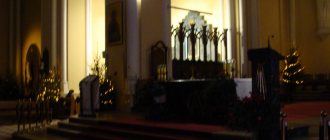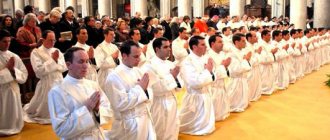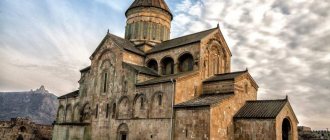Dogmatics of the Catholic Church
Religious movements of heretics in Western European countries Read more: Heresies of the developed Middle Ages
1. Dogmatics of the Catholic Church
The doctrine of the Roman Catholic Church is very closely intertwined with ritual rites. Therefore, in order to understand a number of religious issues from the point of view of the Catholic Church, it is necessary to understand how the ritual side of the service is practically carried out. What is the church in the understanding of Catholics?
With the blessing of the Roman Catholic Church, many cultural traditions of “pagan” antiquity with its free-thinking were consigned to oblivion and condemned. True, the church tradition, which cultivated Latin, contributed to the preservation of a significant part of the manuscript heritage of ancient culture. However, much was irretrievably lost, and, above all, spiritual freedom. Catholic priests (who took a vow of celibacy and therefore were not bound in their activities by personal and family interests, who devoted themselves entirely to the service and interests of the church) jealously monitored the strict observance of church dogmas and rituals, mercilessly condemned and punished heretics, which included everyone who dared to deviate from the official teaching in any way. The best minds of medieval Europe perished at the stake of the “holy” Inquisition, and the church willingly sold the rest, the intimidated and humbled “sinners,” for a lot of money—indulgences—absolution of sins.
It is advisable to consider within the framework of this chapter the characteristic features and dogmas of the Christian doctrine, whose name is Catholicism.
Catholicism is one of the main directions in Christianity.
Being a variety of the Christian religion, Christianity recognizes its basic dogmas and rituals; at the same time, it has a number of features in its doctrine, cult, and organization. The Church in Catholicism is a mediator between God and people. The Church imparts God's grace to people through the sacraments.
The organization of the Catholic Church is characterized by strict centralization, monarchical and hierarchical character. According to K.'s doctrine, the Pope (Roman high priest) is the visible head of the church, the successor of the Apostle Peter, the true vicar of Christ on earth; his power is higher than the power of the Ecumenical Councils. [2, p. 345]
Let's look at the basic tenets of Catholicism.
— Dogma of the infallibility of the Pope.
— The Catholic Church recognizes not only the “Holy Scripture”, i.e. the Bible, as the source of its doctrine, but also the “Sacred Tradition”, or tradition. Moreover, the “sacred tradition” includes, in addition to the ancient oral tradition, the decrees of the first 7 Ecumenical Councils (as Orthodoxy does) and the decisions of subsequent church councils, papal messages.
- The dogma of the Trinity - the “holy spirit” comes not only from God the father (as in the “Creed” recognized by Orthodoxy), but also from the son (filioque).
— The dogma of mandatory celibacy for the clergy is celibacy. In Orthodoxy (by comparison), only monasticism takes a vow of celibacy.
- The sacrament of communion - communion with bread and wine - only for the clergy, with one bread - for the laity.
— The Catholic Church prohibits leaving the clergy.
— Church teaching about the “treasury of overabundant grace” (which does not exist in Orthodoxy): the acts of Christ, the apostles, the Mother of God, saints, as well as the “extraordinary” deeds of pious Christians create a “reserve” of good deeds and “grace”, due to which the church has the right forgive sins by granting forgiveness to sinners.
- The dogma of purgatory - an intermediate authority between hell and heaven, where the souls of the dead, awaiting their final fate, can be cleansed of sins that they did not atone for during life, going through various kinds of tests, as well as with the help of prayers for them and the “good deeds” of their loved ones on the ground. The clergy has the power to shorten the period of stay in purgatory.
— Dogma of the Immaculate Conception of the Virgin Mary and her bodily ascension.
In order to instill in ordinary people the consciousness of their complete insignificance and to reconcile them with their position, the Catholic Church launched the dogma about the original sinfulness of man's earthly existence. The Church declared every person initially incapable of “saving his soul.” According to Catholic teaching, only the papal church, endowed with the special right to distribute “divine grace” in the world through the sacraments it performs, is in charge of the “salvation” and “justification” of the entire earthly world. [1, p. 69]
The Catholic Church, like the Orthodox Church, recognizes seven sacraments, but there are some differences in their administration. Thus, Catholics perform baptism not by immersion in water, but by pouring it over; Confirmation (confirmation) is not performed simultaneously with baptism, but for children no younger. 8 years and, as a rule, a bishop. Catholics have unleavened communion bread, not leavened bread (like the Orthodox). A lay marriage is indissoluble, even if one of the spouses is convicted of adultery.[2, p. 346]
The highest Catholic clergy, led by the pope, claimed to establish their political hegemony, to subjugate all secular life, secular institutions and the state as a whole. The Catholic Church not only announced its claims, but also tried to realize them, using its political influence, military and financial power, as well as taking advantage of the weakness of the central government. Papal diplomats, church tax collectors and indulgence sellers filled all the countries of Europe.
The claims of the Catholic Church caused discontent even among large secular feudal lords. Even greater dissatisfaction with the church and its propaganda of contempt for secular life was felt among residents of developing and increasingly wealthy cities, in which a new bourgeois ideology was emerging.[1, p.71]
As you know, for many centuries Catholicism was the dominant ideology in Western Europe. The role of the Catholic Church was especially great in the era of feudalism. During the Middle Ages, as a major land owner, the Catholic Church achieved significant political influence in the feudal world. The papacy sought to subjugate secular power (especially in the 11th-13th centuries), made claims to world domination, and organized Crusades to expand the area of its influence (beyond Western Europe).
With the formation of centralized states within the Catholic Church, tendencies for the autonomy of national churches arose (the teachings of Wycliffe, Gallicanism, etc.); from 14th-15th centuries resistance to the autocracy of the popes became increasingly widespread, the so-called Council movement arose, demanding the supremacy of the Ecumenical Councils over the pope.[2, p.347]
So, having studied the features of the Catholic confession and examined the dogmas of the Catholic Church, we can draw some conclusions. The Catholic Church of the Middle Ages is characterized by the splendor of its decoration and cult. Most likely, the Church teaching about the “treasury of overabundant grace” became the basis for the start of the sale of indulgences. The laity's dissatisfaction with church exactions is gradually growing. The sale of indulgences, excessive exactions, the desire of the papacy to establish itself in secular power - all these are objective prerequisites for the emergence and development of heretical movements.
Heresies were brutally suppressed by the Catholic Church; it resorted to excommunications - interdicts.
Struggling for dominance over minds, the Catholic Church brutally persecuted advanced scientific thought: just remember the trials of G. Bruno, G. C. Vanini, G. Galileo and others.
The next chapter will focus on a detailed examination and study of those very heretical movements that arose on the basis of people's dissatisfaction with the current religious situation.
Religious movements of heretics in Western European countries Read more: Heresies of the developed Middle Ages
Information about the work “Religious movements of heretics in Western Europe”
Section: Religion and Mythology Number of characters with spaces: 47225 Number of tables: 0 Number of images: 0
Similar works
Development of law in Western Europe
106476
0
0
… absolute monarchy. However, unlike continental Europe, English absolutism had a number of features that make it possible to define it as “unfinished.” 3. Fundamentals of feudal law in Western Europe 3.1 Salic truth The formation of statehood among the Frankish tribes was accompanied by the creation of law. This was carried out with the help of a stock of ancient Germanic customs. This is how "...
Modern political science of Western Europe
46167
0
0
... be called “Machiavellianism.” Many statesmen and politicians in various countries used Machiavelli's recommendations in their political activities. Simultaneously with political teachings defending private property and the state, which guards the interests of the exploiting classes, publications began to appear in Western Europe condemning this property and generated...
Political and legal doctrines in Western Europe during the Middle Ages
35425
0
0
... ideology, up to the proclamation of him as a “saint”, “angelic doctor”. In a special encyclical of the Pope in 1879, the teachings of Thomas Aquinas were declared “the only true philosophy of Catholicism.” 3. Political and legal ideas of medieval heresies During the Middle Ages, heretical movements were a form of political and legal ideology in opposition to feudalism. Heresies operated with the same...
Religious Reformation in Europe
43573
0
0
... the ideal of monastic solitude for the sake of personal salvation, characteristic of Benedictineism. Heresies of the second half of the XII-XIII centuries. Establishment of the Inquisition. Researchers identify the 12th century. in the history of Western Europe in connection with profound changes in mass religious consciousness. Sometimes they even talk about the internal Christianization of Europe in the 12th century, contrasting it with the external, formal affirmation of Christianity in...
Nazi gold in the Vatican Bank
0
Source:
The Institute of Religious Affairs (aka the Vatican Bank) was founded by papal decree of Pope Pius XII in June 1942. Three years later, according to a report from a US Treasury agent, the bank received approximately 2 million francs smuggled from Germany with the help of the puppet regime. Yes, they accepted Nazi gold (and we all know what kind of gold it is and how many people died for it), but the Vatican Bank did not stop there. It is believed that the money was immediately sent to Spain and South America, where it was used to help surviving Nazi officers and officials facing execution for their crimes against humanity. A report on this was written in 1947, but somehow almost immediately got lost, and was later classified. The Church’s “friendship” with the Nazis began back in 1929 with the signing of the Lateran Agreements between Cardinal Pietro Gasparri and Italian Prime Minister Benito Mussolini. The agreements regulated the rights and privileges of the Catholic Church, as well as its position in the Kingdom of Italy, the lower house of parliament of which then consisted entirely of members of the Fascist Party.
Caused problems for Jewish children after World War II
0
Source:
Despite the deathly silence during the Holocaust, the Catholic Church did try to help the Jewish people, but in its own way, in its own way. They helped save thousands of Jews from certain death by providing them with falsified birth certificates and documents that identified them as Catholics. In France, Jewish children were hidden from the Nazis in church schools. Of course, this was wonderful, but the problem arose after the war ended. The Catholic Church issued a decree prohibiting Jewish children from returning to their families. The document states that their return to their faith and to their people would mean that they had bought themselves off from the Catholic faith, which was unacceptable. This phenomenon was called the “No Return Policy for Jewish Children.” Saving Jewish children from the Nazis, they were baptized and hidden in schools and orphanages. But when the war ended, the children were not returned to their parents, claiming that they should now be raised by Christians. Some of the children grew up without even knowing their true families or origins. It is still unclear exactly how many children they did not return after the war.
Magdalene Asylum
0
Source:
Based on ultra-conservative concepts, the Catholic Church imprisoned women suspected of prostitution or promiscuity in special institutions - Magdalene asylums. Initially, women in these institutions were forced to undergo pseudo-psychiatric treatment in order to get rid of their perceived sinfulness and promiscuity. Many women were sent to these shelters by their families. This happened mainly in Ireland, the arrested women were forced to slave labor - this was daily washing of clothes seven days a week. The church received money for washing, because laundries were commercial establishments. Prisoners suffered severe beatings, received meager food, and were constantly subjected to sexual violence. It was estimated that more than 30,000 women were forced to work in Irish laundries. Asylums operated in Ireland from the 18th to the late 20th century, but did not come to public attention until 1993, when 155 bodies were discovered in a mass grave in North Dublin. The management of the shelter buried the women in secret, without informing either their families or even the authorities about their death - none of the unfortunate people had a death certificate. In 2013, Irish authorities agreed to pay at least $45 million in compensation to survivors. This decision was made after the UN Committee against Torture drew attention to the situation. However, the Catholic Church has yet to issue an apology.
Ritual murder of a nun
0
Source:
American Catholic priest Gerald Robinson was found guilty of murdering a nun. The body of the crime victim, 71-year-old Sister Margaret Ann Pahl, was discovered in 1980 in the hospital chapel. Signs of strangulation and 31 stab wounds to the chest were found on the body. These cross-shaped wounds were inflicted, according to pathologists, by a letter opener found in Robinson's room. The priest was arrested in 2004, but was released on bail: his supporters and parishioners raised 200 thousand dollars for this purpose. 26 years after the murder, the investigation was reopened thanks to Claudio Vercellotti of the Society for the Aid of People Abused by Priests. She stated that there was evidence of sexual abuse by a certain satanic cult in which Reverend Robinson took part. After the verdict was announced, one of Gerald Robinson's supporters told her: "I hope you rot in hell." However, this time he sat down - but did not sit in prison for long, as he died in prison a few years later.
Repatriation of children
0
Source:
To ensure the maintenance of a healthy white majority population in the colonies, the British deported approximately 150,000 children to Rhodesia, Canada, New Zealand and Australia during the 19th and 20th centuries. Religious organizations, including the Catholic Church, saw this as an opportunity to increase their numbers of followers and took part in the repatriation. Representatives of the church provided themselves with a guaranteed flock on other continents. Everything would be fine, but the children were not just taken from home, but sent to hard labor. Children were starved, beaten and often raped. Only in 2001, the Catholic Church of Australia confirmed the authenticity of those crimes, and finally apologized. Holy Fathers, it's too late!
Irish Homes for Unmarried Mothers
0
Source:
The Irish government has ordered a full investigation into mother and baby homes after a grave containing the bodies of nearly 800 children was found near a Catholic institution in Galway. The Catholic institution, a mother and baby home where unmarried mothers found shelter, had a mortality rate four or five times higher than the usual average mortality rate in the region at that time. According to experts, the dead children ranged from two days to nine years old. It is now alleged that they died due to illness and constant malnutrition. Authorities ordered an investigation into cases of forced adoption, in which mothers were taken away from their children in Catholic mother and baby homes and sent to “re-education”, as well as the excessively high mortality rate in such institutions. The burial in a house in the west of Ireland was discovered 40 years ago, but then experts believed that the dead fell victim to a massive famine, the peak of which occurred in Ireland in the 40s of the 19th century. According to the Guardian newspaper, local residents learned about the existence of this grave in 1975. Then two little boys accidentally broke a concrete slab. After this, the priest read a prayer at the grave, and the mass grave was sealed again.
Help the Nazis escape
0
Source:
By some estimates, after the end of World War II, approximately 9,000 Nazis managed to escape to South America. Many believe that the Catholic Church helped a large number of these war criminals get there and escape punishment for their crimes. There are numerous proven cases in which high-ranking Nazi officials were issued false Vatican passports, allowing them to travel disguised as priests. The most famous is the case of Stangl. Franz Stangl - Nazi war criminal, SS Hauptsturmführer, commandant of concentration camps - Sobibor, Treblinka. It was smuggled from Germany to Brazil by a bishop named Hudal. Franz Stangl, who remained free until 1967, when he was arrested in Brazil. Stangl was then extradited to West Germany and convicted of the mass murder of 900,000 Jews. The participation of the Church in this remains a controversial issue. The official position is that Hudal acted independently, without the approval of the Vatican. But a number of historians argue that the role of the Church in organizing the escapes could have been much greater.
Protecting rapists and pedophiles
0
Source:
The Catholic Church hates discussing child abuse, which has been widely reported in the media since the 1980s. Officials were quick to point out that other religious institutions also have similar problems, but the bottom line is this: the problem exists. And what's worse is that they knew about it for years and tried to hide it. The revelation of pedophilia caused huge scandals. It is unknown how long this practice actually lasted, but certainly no less than 30 years. Some of the Catholic holy fathers raped dozens of children, and they were not even defrocked. Just one example is Father Lawrence Murphy. He worked at a school for deaf boys and was found to have molested more than 200 boys during his 24 years of work. When the Church became aware of his abuses, he was transferred from one parish to another, and when he finally went to Rome to answer for his crimes, they decided that he was too old and weak to be punished. This story served as the basis for the documentary film Mea Maxima Culpa: Silence in the House of God.
Collaboration with the Nazis
0
Source:
After Italy was unified in the 19th century, the Pope lost many sovereign territories. This caused a rift between the government of the time and the church. But when Italy fell under the fascist dictatorship of Benito Mussolini, the crisis was resolved. In order to have the church on their side, the fascists offered a deal that the church could not but agree to. In exchange for their public support, the church received a sovereign state in Italy (Vatican City), a hefty sum of cash, tax exemption, and government salaries. Catholicism was also named the state religion of Italy, and Mussolini made it a compulsory subject in all schools. The Catholic Church kept its word, and after they came to an agreement with the new regime, a statement was immediately published in the official Vatican newspaper praising Mussolini. In particular, it said: “Italy returned to God, and God returned to Italy.” Dictator Benito Mussolini always maintained very close ties with the Catholic Church. In 1929, the Pope and the Catholic Church received various preferences. Thus, the church was given the right to prosecute people who spoke negatively about the Pope or the Catholic Church.
